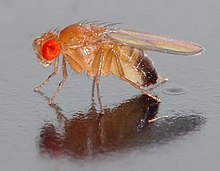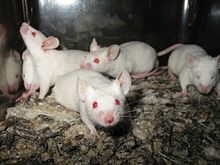Model organism
Model organisms are selected bacteria , viruses , fungi , plants or animals that can be grown and examined using simple methods and are therefore of great importance for biological and biomedical research. As a rule, they are characterized by a short generation time as well as an inexpensive and uncomplicated attitude and are very well documented in many ways. In addition, they were among the first organisms whose complete genome was deciphered. Lines or strains of practically all model organisms exist that are specially bred for use in research. The methods for examining them are usually well established and documented.
The choice of the model organism depends primarily on the biological issue. Basic cell biological processes can, for example, be investigated well in less complex single cells . For developmental studies, on the other hand, you usually need multicellular organisms . Immunologists often work with mice because the immune system first developed in the vertebrates. Research on model organisms is also widespread in genetics , molecular biology and pharmacology . The attempt is made to obtain generally valid knowledge that can be transferred to other organisms, including humans.
In biomedical research, the term animal model is used in particular for certain animal species or breeding lines that develop a certain disease spontaneously or after targeted treatment . Research on such animal models should provide information on the causes and treatment of human diseases. The transferability of the results of animal experiments to humans and their ethical evaluation are, however, controversial.
Examples
bacteria

The bacteriology uses as model organisms especially the gram-negative bacterium Escherichia coli and the Gram-positive bacterium Bacillus subtilis . Non-pathogenic strains of both types are available for research. However, the corresponding research results can often also be applied to the corresponding pathogenic variants, such as B. enterohaemorrhagic Escherichia coli (EHEC) and Bacillus cereus , as well as other clinically relevant bacteria and are therefore also of importance for medicine. Both bacterial strains are also used industrially in various forms in biotechnology. Another model organism used primarily in biotechnology is the soil bacterium Agrobacterium tumefaciens . As a representative of the actinomycetes , Streptomyces coelicolor has been intensively researched. Because of the knowledge about basic biological processes, such as replication , transcription and translation , which were achieved in the investigation of E. coli , its importance as a model organism goes far beyond bacteriology. In particular, the study of bacterial viruses ( bacteriophages ), such as lambda and T4 , has contributed to the understanding of the gene structure and gene regulation .
Archaea
Despite the sometimes difficult cultivation in the laboratory can through the study of organisms from the kingdom of Archaea also important insights for evolutionary biology and biochemistry are obtained. Examples of model organisms are representatives of the methane formers , halophiles , thermococcales and sulfolobales .
Mushrooms
The mold Neurospora crassa from the sac fungus division is one of the most important model organisms from the mushroom kingdom. For example, it was used by George Beadle and Edward Tatum in their experiments to develop the "one gene, one enzyme" hypothesis for mutation experiments . Another fungus used primarily in cell biology as a model organism is baker's yeast ( Saccharomyces cerevisiae ) , which also belongs to the hose fungi .
plants

The thale cress ( Arabidopsis thaliana ) was the first plant in 1999 whose genome was completely deciphered. It is mainly used for research on cell biology, molecular biology and the developmental biology of plants.
Due to its simple organization and short life cycle, the deciduous moss Physcomitrella patens has long been a model organism of developmental biology and molecular evolution of plants. Additional advantages are the ease of cultivation, the haploid genome and very efficient homologous recombination . The genome was completely sequenced in 2007 as the first genome of a land plant outside of flowering plants . Physcomitrella patens is also increasingly used in biotechnology . Various ecotypes , transgenic strains and mutants - including numerous knockout mosses - are deposited at the International Moss Stock Center for research purposes.
Invertebrates

The fruit fly Drosophila melanogaster has become popular as a model organism primarily through cross-breeding experiments in genetics. The advantage here is that this species can be bred with a high number of organisms with little effort, has only four pairs of chromosomes and genetically determined phenotypic deviations from the wild type, for example in the anatomy and morphology of the animals, can be easily and often recognized with the naked eye. The bristle worm Platynereis dumerilii is considered a living fossil and is therefore of interest for phylogenetic studies. The nematode Caenorhabditis elegans , the first multicellular organism with a fully sequenced genome in 1998, is of particular interest in developmental biology. Its complete development up to exactly 959 cells of a fully grown hermaphrodite ( Eutelia ) is documented in detail.
Vertebrates
- Amphibians
The clawed frog ( Xenopus laevis ) is mainly used in embryology and developmental biology.
- Birds
A frequently used model organism from the field of birds is the domestic fowl ( Gallus gallus domesticus ). Research areas that chickens prefer to use include embryology, virology , immunology , breeding research and developmental biology in the area of limb development.
- fishes

The zebrafish ( Danio rerio ), often referred to as the zebrafish, is popular as a model organism in developmental biology and genetics because of its short generation cycles and the fact that its embryos develop completely outside of the mother and are transparent. A special cultivated form of the Aland, the golden orfe ( Leuciscus idus ), is mainly used in ecotoxicology . The medaka is also used for investigations.
- Mammals

The color mouse ( Mus musculus f. Domestica ) and the rat ( Rattus norvegicus ) are mainly used in basic biomedical research. For this purpose, a number of inbred lines were bred from both species . These are partly characterized by a particular susceptibility to certain diseases and are then used as animal models for these diseases. These include, for example, the NOD mouse and the BB rat for type 1 diabetes or the SHR rat ( Spontaneous Hypertension Rat ) for essential high blood pressure . Special mouse strains without thymus ( nude mice ) are of interest for cancer research and experimental transplant medicine because of the lack of cellular immune defense . Targeted deactivation of a gene ( gene knockout ) in so-called knockout mice and cross-breeding of congenic lines enables the function of an individual gene or a small gene segment to be examined more closely.
In domestic dogs hereditary diseases are known more than any other living being, apart from man. Almost half of these diseases are breed-specific or limited to a few dog breeds. The generalized progressive retinal atrophy (PRA) is an incurable progressive death of the retina, with the result of blindness. The disease was first described in dogs in 1911, and in humans it has long been known as retinopathia pigmentosa . The disease, which can be triggered by multiple genetic defects, affects numerous dog breeds, and many of the triggering genes have already been identified. For some forms of progressive retinal atrophy in dogs, the suitability for the animal model of retinopathia pigmentosa in humans is being tested, dogs of the Briard breed with a special form of the disease have already been successfully subjected to gene therapy, and there is hope that such research into therapies for human retinopathia pigmentosa and some fatal enzyme storage diseases result.
Web links
- The Neurospora Home Page (English)
- The Arabidopsis Information Resource (English)
- Introduction to Drosophila (English)
- Nematode Information Resource (English)
- Xenbase: a Xenopus web resource (English)
- ZFIN - The Zebrafish Information Network (English)
- The Whole Mouse Catalog (English)
- cosmoss: A Physcomitrella web resource
literature
- Burke H. Judd: Experimental Organisms Used in Genetics. In: Encyclopedia of Life Sciences . John Wiley & Sons Inc., Chichester 2001, doi: 10.1038 / npg.els.0000814 .
- Wilhelm Seyffert (Ed.): Textbook of Genetics. Spektrum Akademischer Verlag, Heidelberg 2003, ISBN 3-8274-1022-3 .
- Lewis Wolpert and Others: Developmental Biology. Spektrum Akademischer Verlag, Heidelberg 1999, ISBN 3-8274-0494-0 .
- Pamela M. Carroll, Kevin Fitzgerald: Model Organisms in Drug Discovery. John Wiley & Sons, Hoboken, NJ 2003, ISBN 0-470-84893-6 .
See also
Individual evidence
- ↑ John A. Leigh, Sonja-Verena Albers, Haruyuki Atomi, Thorsten Allers: Model organisms for genetics in the domain Archaea: methanogens, halophiles, Thermococcales and Sulfolobales . In: FEMS Microbiology Reviews . tape 35 , no. 4 , July 2011, p. 577-608 , doi : 10.1111 / j.1574-6976.2011.00265.x .
- ^ Ralf Reski (1998): Physcomitrella and Arabidopsis : the David and Goliath of reverse genetics . Trends in Plant Science 3, 209-210, doi: 10.1016 / S1360-1385 (98) 01257-6 .
- ^ Rensing SA, Lang D, Zimmer AD, et al. : The Physcomitrella genome reveals evolutionary insights into the conquest of land by plants . In: Science . 319, No. 5859, January 2008, pp. 64-9. doi : 10.1126 / science.1150646 . PMID 18079367 .
- ↑ a b Regina Kropatsch. Molecular genetic studies in dogs: genome-wide analyzes of generalized progressive retinal atrophy and mitochondrial and Y-chromosomal studies on genealogical ancestry. Dissertation, Ruhr-Universität Bochum, Bochum 2011, pp. 9–22 Online PDF 2,650 kB , accessed on August 27, 2013.
- ↑ Elaine A. Ostrander , Francis Galibert and Donald F. Patterson: Canine genetics comes of Age. In: Trends in Genetics, vol. 16, No. 3, 2000, doi: 10.1016 / S0168-9525 (99) 01958-7 , pp. 117-124.
- ↑ Konrad Kohler, Elke Guenther and Eberhart Zrenner: Animal models in retinitis pigmentosa research. In: Clinical monthly sheets for ophthalmology, vol. 211, 1997, ISSN 0023-2165 , pp. 84-93.
- ↑ Simon Petersen-Jones: Advances in the molecular understanding of canine retinal diseases. In: Journal of Small Animal Practice , vol. 46, 2005, ISSN 0022-4510 , pp. 371-380, doi: 10.1111 / j.1748-5827.2005.tb00333.x .
